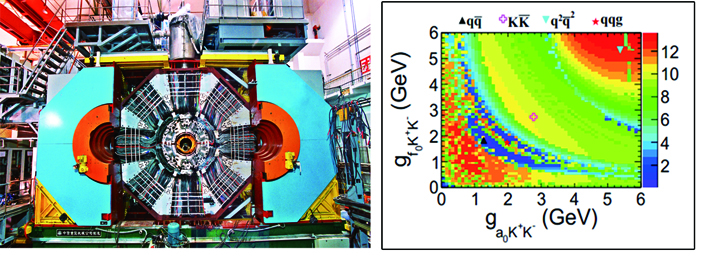
Left: The Beijing Spectrometer (BESIII) Experiment at the Institute of High Energy Physics, Chinese Academy of Sciences in Beijing.
Right: The statistical significance of the signal scanned in the two-dimensional space of ga0K+K- and gf0K+K-. (Credit: BESIII Collaboration)
Scientists in Beijing have observed the mixing of two light scalar mesons, a00(980) and f0(980), using data samples accumulated with the Beijing Spectrometer (BESIII). This observation may help clear up what the 980 MeV scalar mesons are made of (e.g., a tetraquark, a meson molecule, or a quark-gluon hybrid).
Although light scalar mesons a00(980) and f0(980) are well-established in experiment, explanations about their nature have been controversial for several decades. These two states, with similar masses but different decay modes and isospins, are difficult to accommodate in the traditional quark-antiquark model and many alternative formulations have been proposed to explain their internal structure, including tetraquark state, KKmolecule, or quark-antiquark gluon hybrid.
The mixing mechanism in the system of a00(980) -f0(980), which was first proposed in the late 1970s, is considered to be an essential approach to clarifying the nature of these two states. However, the direct measurement of the mixing signals was only made possible with the world’s largest data samples of 1.31×109J/ψ and 4.48×108ψ(3686) events accumulated with the BESIII detector. The signals of f0(980)→a00(980) and a00(980)→f0(980) were first observed with statistical significances of 7.4σ and 5.5σ, respectively.
This direct measurement of a00(980) -f0(980) mixing is a sensitive probe to the internal structure of those ground state scalars and shed important light on their nature. The new results from BESIII provided critical constraints to the development of theoretical models for a00(980) and f0(980). Now it is the theorists' turn to refine the calculations to understand the inner structure of the a00(980) and f0(980) mesons.
Despite its relatively smaller size, the BESIII experiment at the Beijing Electron Positron Collider is a world-leading facility in the domain of τ-charm physics and attracts some 450 physicists from 14 countries to work on it as a team. To date, the BESIII collaboration has published more than 200 papers.

